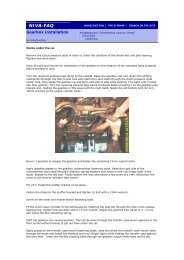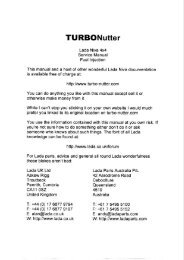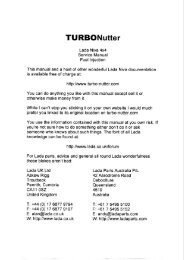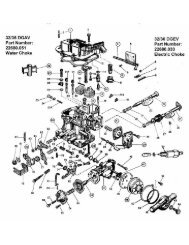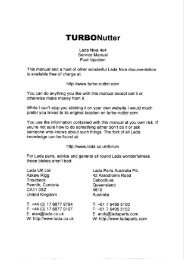WEBER CARBURETOR TROUBLESHOOTING GUIDE - Niva Manuals
WEBER CARBURETOR TROUBLESHOOTING GUIDE - Niva Manuals
WEBER CARBURETOR TROUBLESHOOTING GUIDE - Niva Manuals
You also want an ePaper? Increase the reach of your titles
YUMPU automatically turns print PDFs into web optimized ePapers that Google loves.
<strong>WEBER</strong> <strong>CARBURETOR</strong><br />
<strong>TROUBLESHOOTING</strong> <strong>GUIDE</strong><br />
G. Testing the idle mixture adjustment:<br />
Adjust with the engine at idle speed; turn the mixture adjustment screw in<br />
(clockwise) by quarter turns until the engine speed drops; turn out<br />
(counter clockwise) while counting quarter turns until the idle rises and<br />
again drops noticeably; turn in again to middle setting.<br />
If RPM does not change go to 5H<br />
H. Cleaning the idle circuit<br />
Locate and remove the primary idle jet holder (this is also the idle solenoid<br />
if so equipped). Remove the jet from the holder, hold up to a light and check for<br />
roundness of the cavity. Remove the idle mixture screw from the the carburetor,<br />
blow clean compressed air through the two open passages. Replace the jet<br />
in the holder and install back in the carburetor along with the idle mixture screw.<br />
I. Make sure that all of the vacuum lines are installed to the correct signal source.<br />
Install a vacuum pump with a gauge. Start engine and operate throttle.<br />
If vacuum is present at idle it is a manifold vacuum source. If vacuum is present<br />
at partial throttle it is a ported vacuum source. If vacuum is present at a high<br />
rpm it is a venturi vacuum source.<br />
Refer to your shop manual or any labels under the hood that show vacuum<br />
hose routing.<br />
J. Set the Float Level<br />
Float level problems are very rare with New Weber Carburetors. Refer to a<br />
Weber Shop manual or contact your Weber Dealer for specifications or<br />
instructions. Also check for dirt or other foreign matter in the needle and seat.<br />
6. PERSISTENT PROBLEMS<br />
The following problems are not listed in the guide because they are unique,<br />
difficult to diagnose and are beyond the scope of the guide. We have listed<br />
them because of past experiences.<br />
A. Replace spark plugs; use only new spark plugs with the correct heat range.<br />
B. Make sure that the ground strap is properly connected. It is necessary that<br />
the engine is grounded to the chassis and battery.<br />
C. Double check or have any work coincidental to the problem such as<br />
body work or engine repairs, a tune up , installation of an alarm, stereo or<br />
emissions inspection.<br />
D. Check for any damage to the exhaust system or an internally collapsed muffler.<br />
E. Check your sparkplugs. Most Shop manuals have a chart in color showing<br />
what the spark plugs should look like. Rejetting of the carb may be necessary.<br />
F. See if the Transmission is slipping. This applies to both automatic and standard.<br />
G. Make sure that the fuel tank vent hose is not plugged at the canister.<br />
H. Some Vehicles , including Nissans, have two wires that go to the electric choke.<br />
One is a ground wire and does not have to be connected.<br />
I. Some original Electric Fuel pumps pressure exceeds 3.5 psi. Check with a<br />
pressure gauge or look in shop manual. A pressure regulator may be necessary.<br />
J. On some water cooled VW's , vibrations caused by worn motor mounts may<br />
cause the carburetor top to fracture.<br />
K. When the throttle return spring is located on the same side as the throttle<br />
lever, check to make sure that the first spring coil does not get trapped between<br />
the lever and the carburetor. This will cause binding.<br />
L. On progressive carbs incorrect installation of the throttle lever can cause<br />
Page 6





